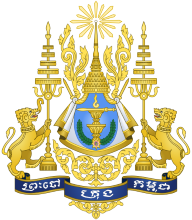Cambodia: Government
Key Figures
- Chief of State:
- King Norodom Sihamoni
- Head of Government:
- Prime Minister Hun Manet
Overview
- Government Name:
- Kingdom of Cambodia
- Constitution:
- Adopted: 1993; Constitution outlines several topics including sovereignty, basic rights and obligations of citizens, the king and his responsibilities as chief of State, defines policy making process, sets economic rules, outlines the education, cultural and social affairs, establishes liberal democracy, describes and delegates to legislative, judiciary and executive branches
- Government Type:
- Multiparty Democracy under a Constitutional Monarchy

Index of Economic Freedom
Country Risk Rating
Government Branches
| Main Powers | Election Process | Election Cycle 1 | |
|---|---|---|---|
| Executive | The king appoints the prime minister from assembly and is also responsible for upholding sovereignty. He is the supreme commander of the armed forces. The prime minister is the head of government, appointing cabinet members and leading the government. |
The king is hereditary. The prime minister is voted on by the assembly and appointed by the king. |
Prime Minister: 5 years |
| Judicial | The judiciary protects the freedom and rights of the citizens. |
Judges of both courts are appointed by the monarch. |
Supreme Court: no term limit, Constitutional Court: judges are appointed for 9-year terms with one-third of the court renewed every 3 years |
| Legislative | The legislature creates laws. |
The senate has 62 members: 58 are elected by members of the national assembly and local commune councilors, 2 are elected by the national assembly, and 2 members are appointed by the monarch. The national assembly has 123 members who are elected by universal adult suffrage. |
Senate: 6 years; National Assembly: 5 years |
Regional Trade Blocs
International Organization Participation [2]
Environmental Agreements [3]
Tax Information [2]
- Tax Authority:
- Information not available
- Tax Name:
- Information not available
Sources:
- ElectionGuide http://www.electionguide.org/
- EY, http://www.ey.com
- CIA World Factbook, https://www.cia.gov/the-world-factbook/
- U.S. Bilateral Relations Fact Sheets http://www.state.gov/r/pa/ei/bgn/


